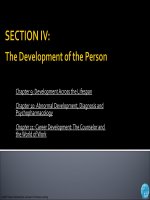The world of the Counselor An introduction to the counseling profession 5e chapter 15
Bạn đang xem bản rút gọn của tài liệu. Xem và tải ngay bản đầy đủ của tài liệu tại đây (737.37 KB, 34 trang )
Knowledge & Skills of Multicultural
Counseling
© 2007 Thomson Brooks/Cole, a division of Thomson Learning
1
Over 33% of Americans are racial and ethnic minorities
Midway through this century minorities will constitute over
50% of the American population
See Figure 15.1, p. 501
Today, vast majority of immigrants are Latin American and
Asian
Changing religious demographics
Changes in sex-role identity
Increased sensitivity to people from different groups
© 2007 Thomson Brooks/Cole, a division of Thomson Learning
2
A Disclaimer: As you read about the various cultural groups,
particularly about behaviors unique to those groups,
remember that some may embrace the unique behaviors
and values of their culture of origin but others may not.
Don’t ever forget the “individual.”
© 2007 Thomson Brooks/Cole, a division of Thomson Learning
3
African Americans
42 million Americans (14%)
90% descendants of slaves
6-10 million died in route from Africa
Laws restricting education, work, etc. well into 1970s
37% of all hate crimes against African Americans
Recently rediscovered their heritage (symbolized by
Kwanza)
Group oriented, value cooperation and interdependence
© 2007 Thomson Brooks/Cole, a division of Thomson Learning
4
Hispanics: People of Central American, South American, and
Caribbean Origin
48 million Americans (16%)
Many from Mexico, Puerto Rico, and Cuba
Each has unique history and culture
Best to have knowledge of client’s country of origin
Extended family is emphasized
Interdependence over independence
Respect based on age, SES, gender, and perceived importance
Patriarchal
Many embrace Catholic values while at the same time believe
in “cultural fatalism”
© 2007 Thomson Brooks/Cole, a division of Thomson Learning
5
People of Asian and Pacific Island Origin
Includes people from 25 countries
Many from: China, Philippines, Korea, India, Vietnam, Hawaii
Unique histories why they sought refuge in U.S.
Some similar values:
▪ Children tend to be obligated to parents
▪ Family members highly interdependent
▪ Generally patriarchal
▪ Guilt and shame to control behavior of family members
▪ Pride themselves in controlling feelings
▪ Formality in social relationships
▪ Mind and body seen as one
▪ Physical complaints--way of expressing psychological problems
© 2007 Thomson Brooks/Cole, a division of Thomson Learning
6
Native Americans
5 million Americans are Native American and one other race
3.2 million (1.0%) only Native American
120,000 are Alaskan Native
Many different Native Americans with unique histories
Millions killed by disease or war brought over from Europe
1.5% of Americans are American Indian heritage
▪ Six tribes = 40%, 252 languages, 22% on reservations
Many social problems on reservations
Mental health viewed from a spiritual/holistic perspective.
Sense of Sense of shared cultural and common core values
© 2007 Thomson Brooks/Cole, a division of Thomson Learning
7
Have the right attitudes and beliefs, gain knowledge, and
learn skills
2. Encourage clients to speak their own language
3. Assess the cultural identity of the client
4. Check the accuracy of your interpretation of the client’s
nonverbals
5. Make use of alternate modes of communication
6. Assess the impact of sociopolitical issues on the client
7. Encourage clients to bring in culturally significant and
personally relevant items
8. Vary the helping environment
1.
© 2007 Thomson Brooks/Cole, a division of Thomson Learning
8
79 religious groups each having over 60,000 members in U.S.
Great variety of religions in U.S. (see Table 14.1, p. 471)
83% claim a religious affiliation and 88% say religion is fairly
or very important
Different histories and cultures
Difference between religion and spirituality:
Religion is “the organized set of beliefs that encode a
person or group’s attitudes toward, and understanding of,
the nature of reality” (Ericksen, 2008, pp. 510-511)
Spirituality is: “mindfulness about the existential qualities
of life, especially the relationship between self, other, and
the world” (Ericksen, 2008, pp. 510–511).
© 2007 Thomson Brooks/Cole, a division of Thomson Learning
9
Brief Descriptions of Some Religions
Christianity:
▪ 2000 yrs. ago.
▪ Jesus
▪ Two billion members (33% of world population)
▪ Many sects
▪ Has offered answers to questions about life’s meaning
and has focused world attention on the importance of
assisting those in need.
© 2007 Thomson Brooks/Cole, a division of Thomson Learning
10
Buddhism:
6th century B.C.E. in India
Based on the Tripaka--teachings of Gautama Siddhartha;
after becoming enlightened, became known as the Buddha
6% of world population.
Four truths:
1. the truth of suffering
2. the cause of suffering, which is desire
3. the cessation of suffering, which is the renunciation of desire
4. the way that leads to the cessation of suffering
© 2007 Thomson Brooks/Cole, a division of Thomson Learning
11
Hinduism:
1500 B.C.E.
13% of world population.
Based on sacred texts: mythological and philosophical
commentaries about life. Divine principle: Many gods are
aspects of a single divine unity.
We are born and reborn based on our separation from the
divine.
Reincarnation is the road to unity with the divine.
© 2007 Thomson Brooks/Cole, a division of Thomson Learning
12
Islam:
Established by Muhammad in 622
18% of world population
Allah (God) is creator of the universe, merciful, kind, & allpowerful
Humans can be misled by Satan
Five duties:
1. profess their faith to Allah
2. pray five times a day
3. give regularly a portion of their material wealth to charity
4. fast daily until sundown during the month of Ramadan
5. attempt to make at least one pilgrimage to Mecca
© 2007 Thomson Brooks/Cole, a division of Thomson Learning
13
Judaism
1300 B.C.E.
0.2 percent of world population
Particularly long history of oppression
Largely assimilated into American culture while holding
onto Jewish heritage
Based on Hebrew Bible which includes the five books of
Moses (called the Torah).
12% of all hate crimes committed against Jews. Jews make
up 2% of U.S. population
© 2007 Thomson Brooks/Cole, a division of Thomson Learning
14
See ASERVIC Fourteen Competencies, pp. 512-513
Six Core Values
Culture and World View
Counselor Self-Awareness
Human and Spiritual Development
Communication
Assessment
Diagnosis and Treatment
See Box 15.1, p. 512: Religion as Projection of Self
© 2007 Thomson Brooks/Cole, a division of Thomson Learning
15
Today, many differences exist between men and women (see
Table 15.1, p. 514)
Gender-Aware Therapy
makes gender central to the therapeutic process
views problems within a societal context
encourages counselors to actively address gender injustices
encourages the development of collaborative and equal
relationships
respects the client’s right to choose the gender roles
appropriate for himself or herself
© 2007 Thomson Brooks/Cole, a division of Thomson Learning
16
Women have unique concerns
Division 17 of APA developed 11 guiding principles for
working with girls and women (see Box 15.2, p. 516)
© 2007 Thomson Brooks/Cole, a division of Thomson Learning
17
Twelve steps:
1. Have right attitudes and beliefs, gain knowledge, and learn skills
2. Ensure that the counseling approach has been adapted for women
3. Establish relationship, give up power, demystify the process
4. Identify social/political issues and use them to set goals
5. Use a wellness model and avoid the use of diagnosis and labels.
6. Validate a woman’s angry feelings toward her predicament.
7. Actively promote healing through learning about women’s issues
8. Provide a safe environment to express feelings
9. Provide a safe environment to understand their anger toward men
10. Help with conflicting feelings between traditional and new values
11. Facilitate integration of client’s new identity
12. Say goodbye
© 2007 Thomson Brooks/Cole, a division of Thomson Learning
18
Thirteen Steps:
1. Have the right attitudes and beliefs, gain knowledge, and learn skills
2. Accept men where they are, as this will help build trust
3. Don’t push men to express what may be considered “softer feelings”
4. Early on in therapy, validate the man’s feelings
5. Validate his view of constraints by male sex-role stereotypes
6. Have a plan for therapy
7. Begin to discuss developmental issues
8. Slowly encourage the expression of new feelings (see Box 15.2, p. 518)
9. Explore underlying issues and reinforce new ways of understanding
10. Explore behavioral change
11. Encourage integration of new feelings, thoughts, and actions
12. Encourage new male relationships
13. Say goodbye
© 2007 Thomson Brooks/Cole, a division of Thomson Learning
19
Kinsey studies found much variability in sexuality
Many Americans sill hold heterosexist attitudes which probably
reflect unconscious fear of the “other”
48% of American continue to believe that being gay, bi, or lesbian is
morally wrong (see Box 15.3, p. 520
However, has been gains in Americans support of gays, lesbians, and
bisexuals
18% of hate crimes against individuals due to sexual orientation
APA has normalized homosexuality in the 1970s
Transgenderism: person who does not identify with his or her birth
sex and lives in congruence with the sex to which he or she identifies
Transsexual: Disidentifies with his or her sex and uses hormones
and/or surgery to realign his or her sex with gender identity
© 2007 Thomson Brooks/Cole, a division of Thomson Learning
20
Eleven Steps:
1. Have the right attitudes and beliefs, gain knowledge, and learn skills
2. Have a gay, lesbian, bisexual-friendly office
3. Help gays, lesbians, and bisexuals understand and combat oppression
4. Adopt an affirmative and nonheterosexist attitude
5. Don’t jump to conclusions about lifestyle
6. Understand differences among gays, lesbians, and bisexuals
7. Know community resources for gay men and lesbian women
8. Know identity issues
9. Understand the complexity of sexuality
10.Understand idiosyncrasies of religious views of homosexuality
11.Recognize the importance of addressing unique issues that some
gays, lesbians, and bisexuals may face
© 2007 Thomson Brooks/Cole, a division of Thomson Learning
21
Individuals Who Are HIV Positive
Over 1 million people in U.S. are HIV positive
56,000 new cases of HIV arise each year
18,0000 individuals die of the disease each year
600,000 Americans have died of AIDS since disease was
identified
33 million children and adults are living with HIV
67% of world’s cases in sub-Saharan Africa
© 2007 Thomson Brooks/Cole, a division of Thomson Learning
22
Counseling Individuals Who Are HIV-Positive
1. Have the right attitudes and beliefs, gain knowledge,
and learn skills
2. Know the cultural background of the client
3. Know about the disease and combat myths
4. Be prepared to take on uncommon counselor roles
5. Be prepared to deal with unique treatment issues
6. Deal with your own feelings about mortality
7. Understand legal and ethical implications relative to
end-of-life decisions
8. Offer a “strength-based” approach to treatment
© 2007 Thomson Brooks/Cole, a division of Thomson Learning
23
The Hungry, Homeless, and the Poor
700,000 Americans homeless on any particular day
3.5 million homeless in one year
Increasingly include women, children, and families
Many are mentally ill
37% of homeless have chronic substance abuse
13% of population is poor
Relationship between race and poverty (see Figure 15.2, p.
524)
McKinney Act provides some services, including mental
health services
© 2007 Thomson Brooks/Cole, a division of Thomson Learning
24
Counseling the Hungry, the Homeless, and the Poor
Have the right attitudes and beliefs, gain knowledge, and
learn skills
2. Focus on social issues
3. Know the client’s racial/ethnic/cultural background
4. Be knowledgeable about health risks
5. Be prepared to deal with multiple issues
6. Know about developmental delays and be prepared to refer
7. Know psychological effects
8. Know resources
9. Be an advocate and stay committed
1.
© 2007 Thomson Brooks/Cole, a division of Thomson Learning
25









